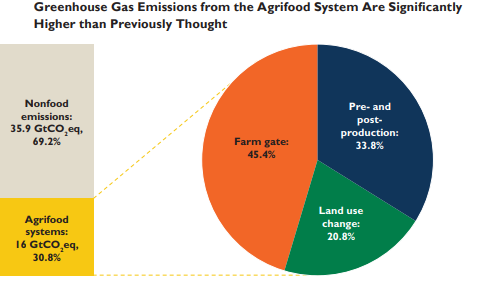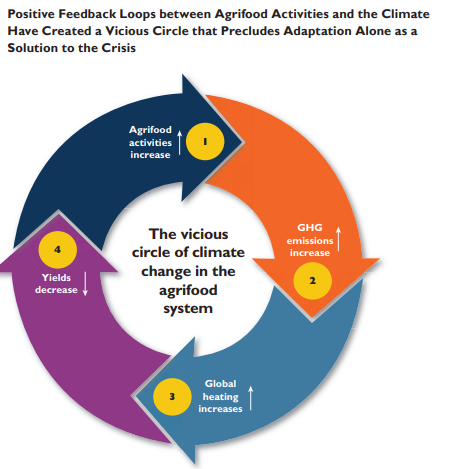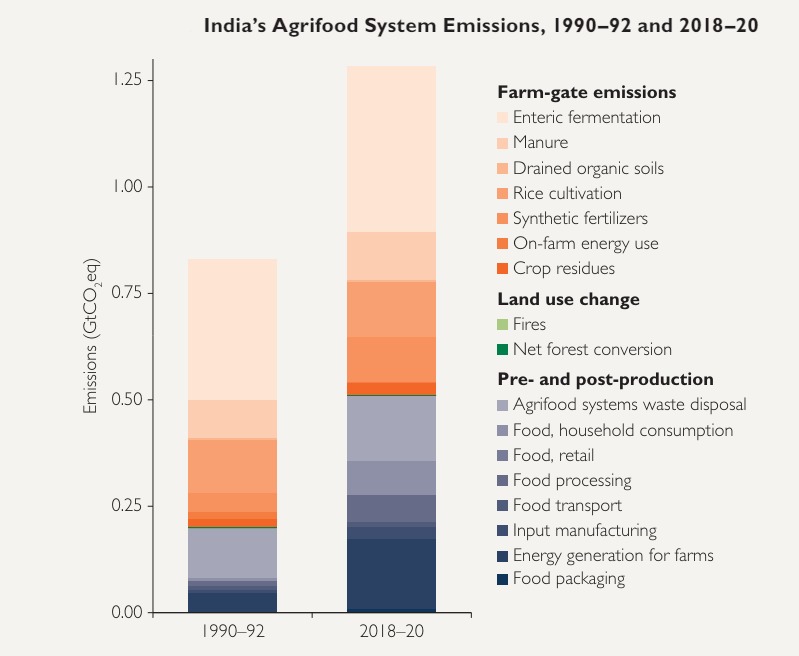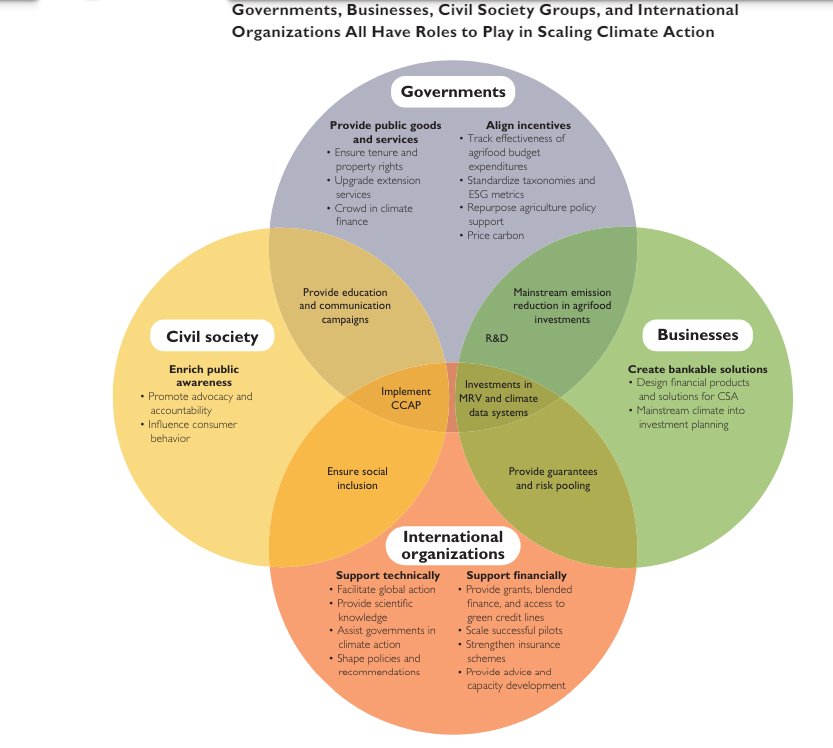Biodiversity & Environment
Recipe For A Livable Planet Report of World Bank
- 11 May 2024
- 8 min read
For Prelims: Carbon sequestration, Agricultural Emissions, GHG Emissions, UNFCCC, Carbon credits, Net zero emissions, General issues on environmental ecology, Climate change, GHG emissions from agriculture
For Mains: Agricultural emissions, Reduction of Agrifood Emissions
Why in News?
Recently, the World Bank released a Recipe For A Livable Planet Report stating that annual investments of USD 260 billion are necessary to cut agrifood emissions in half by 2030 and achieve net zero by 2050.
- The report highlights that this figure is twice the amount currently spent on agricultural subsidies.
What are the Key highlights of the Reports?
- About:
- "Recipe for a Livable Planet" provides a global strategic framework for reducing the agrifood system's impact on climate change.
- It outlines how the world's food production can significantly lower greenhouse gas (GHG) emissions while continuing to ensure global food security.
- Potential and Benefits of Agrifood System Reform:
- Reduction Potential: The global agrifood system can decrease nearly a third of the world’s GHG emissions through feasible and accessible measures.
- These measures will enhance food security, increase the climate resilience of the food system, and protect vulnerable communities during this transition.
- Reduction Potential: The global agrifood system can decrease nearly a third of the world’s GHG emissions through feasible and accessible measures.
- Agrifood's Role in Climate Change:
- Contribution to Emissions: Agrifood contributes roughly one-third of global GHG emissions, more than all of the world’s heat and electricity emissions combined.
- Main Conrtributors of Emissions: About three-quarters of these emissions originate from developing countries, necessitating targeted mitigation actions as per the specific needs of the region.
- Emissions from Food Value Chain: Addressing emissions from the entire food value chain, including land use changes, is critical as over half of the emissions stem from beyond the farm level.
What are the Big Opportunities Reports Highlighted?
- Economic and Environmental Benefits:
- Untapped Potential: The agrifood sector offers significant, cost-effective opportunities for climate action, including drawing carbon from the atmosphere through enhanced land management.
- Return on Investment: The financial outlay required to halve agrifood emissions by 2030 would yield substantial returns, greatly outweighing the costs with beneficial impacts on health, the economy, and the environment.
- Opportunities for Action in Countries and Globally:
- Role of High-Income Countries: These countries should reduce their agrifood energy demands, support lower-income countries through funding and technology transfer, and modify consumer diets away from high-emission foods.
- Middle-Income Countries' Role: These countries can achieve significant emissions reductions through better land use management and agricultural practices.
- Low-Income Countries' Role: Focus on sustainable growth without the burden of high-emission infrastructures, leveraging strategies like agroforestry to boost productivity and resilience.
- Actions at the Country and Global Levels:
- Investment and Policy Initiatives: Enhance private sector investment in agrifood mitigation, repurpose subsidies, and implement policies favoring low-emission technologies.
- Innovation and Institutional Support: Use digital technologies for better emissions data and invest in innovations to transform the agrifood system, ensuring inclusive stakeholder participation for a just transition.
What are the Key Highlights Related to India in the Report?
- India's Contribution to Global Agrifood Emissions:.
- The report identifies India as one of the top 3 countries in terms of total annual agrifood system emissions, along with China, and Brazil.
- Cost-Effective Mitigation Potential in India:
- The report notes that countries like India, around 80% of the technical mitigation potential in agriculture could be achieved by adopting cost-saving measures alone.
- This represents a major opportunity for India to reduce emissions while also improving agricultural productivity and incomes.
- The report notes that countries like India, around 80% of the technical mitigation potential in agriculture could be achieved by adopting cost-saving measures alone.
- Key Mitigation Options for India:
- Key mitigation options for India include better livestock feeding (Harit Dhara, a nti-methanogenic feed) and breeding, fertiliser management, and better water management in water intensive crops.
- A marginal abatement cost curve for India's agriculture sector shows these are some of the most cost-effective interventions India can pursue to cut agrifood emissions substantially by 2030.
- Key mitigation options for India include better livestock feeding (Harit Dhara, a nti-methanogenic feed) and breeding, fertiliser management, and better water management in water intensive crops.
- India needs to curb methane emissions from agricultural production.
- Adopting practices like intermittent irrigation and promoting varieties that emit less methane provide mitigation opportunities.
- India has high rates of food loss and waste. As per Food Waste Index Report 2021, Indian households generate 50 kg of food waste per capita per year.
- Reducing food loss and waste can provides another high-impact, cost-effective avenue for India.
- Need for International Support: India will need international financial and technical support to realise its agrifood mitigation potential.
Way Forward
- Investments: Governments and businesses should de-risk private climate investments in agrifood through blended finance, corporate accountability, and expanding carbon markets.
- Incentives: Policymakers should implement measures to accelerate agrifood system transformation, such as repurposing harmful subsidies, and ensuring policy coherence.
- Information: Improving GHG monitoring, reporting, and verification (MRV) systems using digital technologies can help unlock climate finance for the sector.
- Innovation: Expanding cost-effective mitigation technologies and increasing R&D investments can drive the future transformation of agrifood systems.
- Institutions: International frameworks, national policies, and subnational initiatives must facilitate agrifood mitigation opportunities in a coordinated manner.
- Inclusion: The transformation must ensure a just transition by protecting vulnerable groups like smallholder farmers through stakeholder engagement, benefit sharing and social empowerment.
|
Drishti Mains Question: How can India reduce its emissions from the agrifood system, considering its status as one of the top emitters globally? Discuss potential strategies and their implications for sustainability and food security. |
UPSC Civil Services Examination Previous Year Questions (PYQs)
Prelims:
Q. Gadgil Committee Report’ and ‘Kasturirangan Committee Report’, sometimes seen in the news, are related to (2016)
(a) constitutional reforms
(b) Ganga Action Plan
(c) linking of rivers
(d) protection of Western Ghat
Ans: (d)
Q. Consider the following statements: (2021)
- ‘Right to the City’ is an agreed human right and the UN-Habitat monitors the commitments made by each country in this regard.
- ‘Right to the City’ gives every occupant of the city the right to reclaim public spaces and public participation in the city.
- Right to the City’ means that the State cannot deny any public service or facility to the unauthorized colonies in the city.
Which of the statements given above is/are correct?
(a) 1 only
(b) 3 only
(c) 1 and 2
(d) 2 and 3
Ans: (d)









